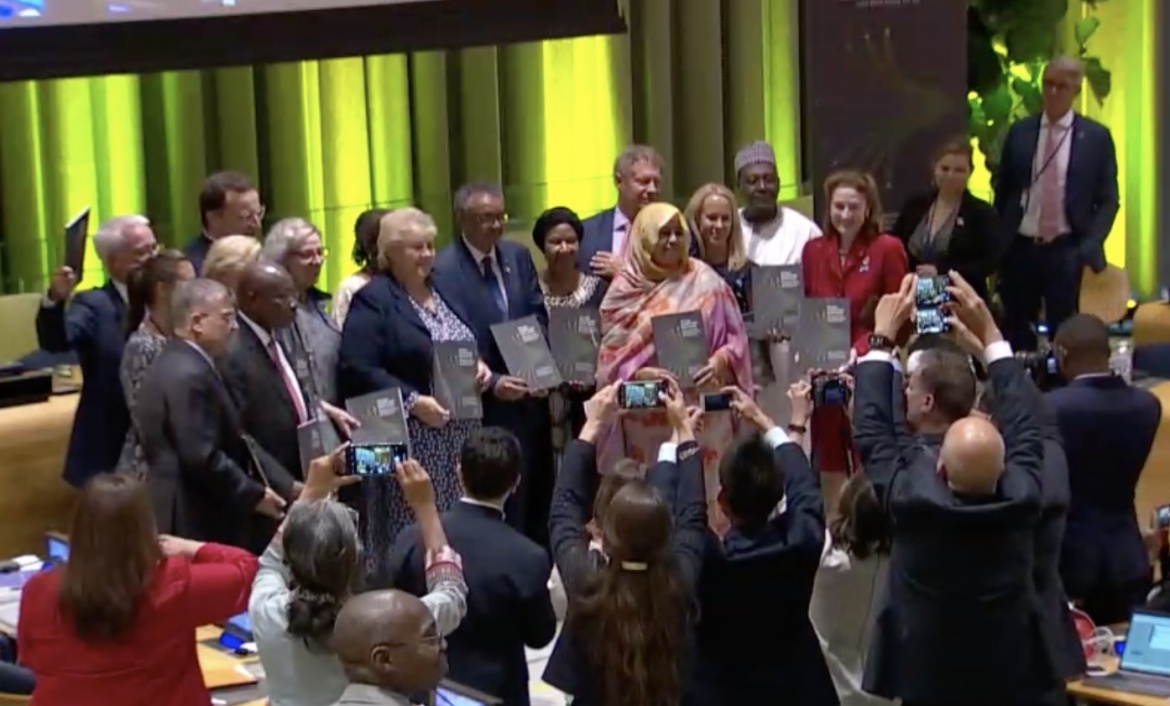World’s leading health and development organisations launch SDG3 Global Plan and commit to GH5050 methods
24 September 2019 | New York
Twelve of the world’s leading health, development and humanitarian organisations launched the Global Action Plan for Healthy Lives and Well-being today at the United Nations General Assembly. In it, signatories commit to using the Global Health 50/50 methodology to develop and strengthen their monitoring frameworks.
The overall objective of the Global Action Plan is to enhance collaboration among its signatories to accelerate country progress on the health-related Sustainable Development Goal (SDG) targets. The Plan presents a new approach to strengthening collaboration among and joint action by the organisations. The 12 signatory agencies to the plan are Gavi, The Global Financing Facility, the Global Fund to Fight AID, TB and Malaria, UNAIDS, UNDP, UNFPA, UNICEF, Unitaid, UN Women, World Bank Group, WFP and WHO.
Global Health 50/50 lauds the signatories for putting gender equality at the heart of the Plan. The Plan elevates gender equality as a key priority across all aspects of the signatories’ collaborative work. GH5050 is pleased to be recognised as a core resource in developing agencies’ monitoring frameworks (see excerpt below; pg xxi) – and is looking forward to supporting signatories in implementing this commitment in any way possible.
“In addition, as a core commitment to accelerate and advance gender equality across the Global Action Plan … the agencies will:
> Incorporate gender specific targets in their monitoring frameworks through methods such as Global Health 50/50 and the United Nations System-wide Action Plan on Gender Equality and the Empowerment of Women.”
As a preliminary resource for Global Action Plan signatories and other interested stakeholders, Global Health 50/50 has published the methodology of its 2019 Report. The guide marks the first publication in a larger How-To Series, which will also include the following (coming in October 2019):
-
- Measuring and Addressing the Gender Pay Gap in Global Health
- How to Develop a Comprehensive Sexual Harassment Policy
- Guide to Parental Leave, Flexible Working and Family-Friendly Workplace Policies
“Through the Global Action Plan, agencies have committed to advancing gender equality in all aspects of their collaborative work. I commend them for committing to using the Global Health 50/50 methodology to track their progress. Because we know, despite growing commitments, that we are still a far cry from gender equality. This comes at the cost of better health, stronger institutions and more just societies – for everyone.”
James Chau, Journalist and Presenter, WHO Goodwill Ambassador
“Delighted to see gender equality front and center in the new Global Action Plan for Healthy Lives and Well-being and agencies committed to using GH5050 methods. Let it mark a leap forward towards more gender-responsive global health and a more gender-equal world.”
Senait Fisseha, Chief Advisor to the Director General of WHO
“Action to address gender inequality is essential to healthy lives and well-being. I look forward to a swift move from commitment to delivering results.”
About the Global Action Plan
In 2018, the leaders of Germany, Ghana and Norway requested that WHO and other multilateral organisations streamline their efforts to better support countries to accelerate progress on Sustainable Development Goal (SDG) 3 – ensuring healthy lives and well-being for all at all ages – and the other health-related targets in the 2030 Agenda for Sustainable Development. That call was echoed in the G20 Osaka Leaders’ Declaration, which urged more effective collaboration between international organisations.
The Global Action Plan is the response – a collective commitment by 12 multilateral organisations with significant roles in health, development and humanitarian work to strengthen their collaboration in support of countries.
The agencies’ mandates range from health financing to normative and policy guidance, technical cooperation, market shaping, convening stakeholders and humanitarian responses. Together, the agencies channel nearly one third of all development assistance for health.
Four commitments form the structure of the Plan, upon which implementation will be based. These include:
- ENGAGE with countries better to identify priorities and plan and implement together
- ACCELERATE progress in countries through joint action under specific programmatic themes and on gender equality and the delivery of global public goods
- ALIGN in support of countries by harmonising operational and financial strategies, policies and approaches
- ACCOUNT, by reviewing progress and learning together to enhance shared accountability
Media release: https://www.who.int/news-room/detail/24-09-2019-multilateral-agencies-launch-a-joint-plan-to-boost-global-health-goals
Video: www.who.int/video/GAP/stronger-collaboration-better-health
Global Action Plan: www.who.int/GlobalActionPlanReport2019


